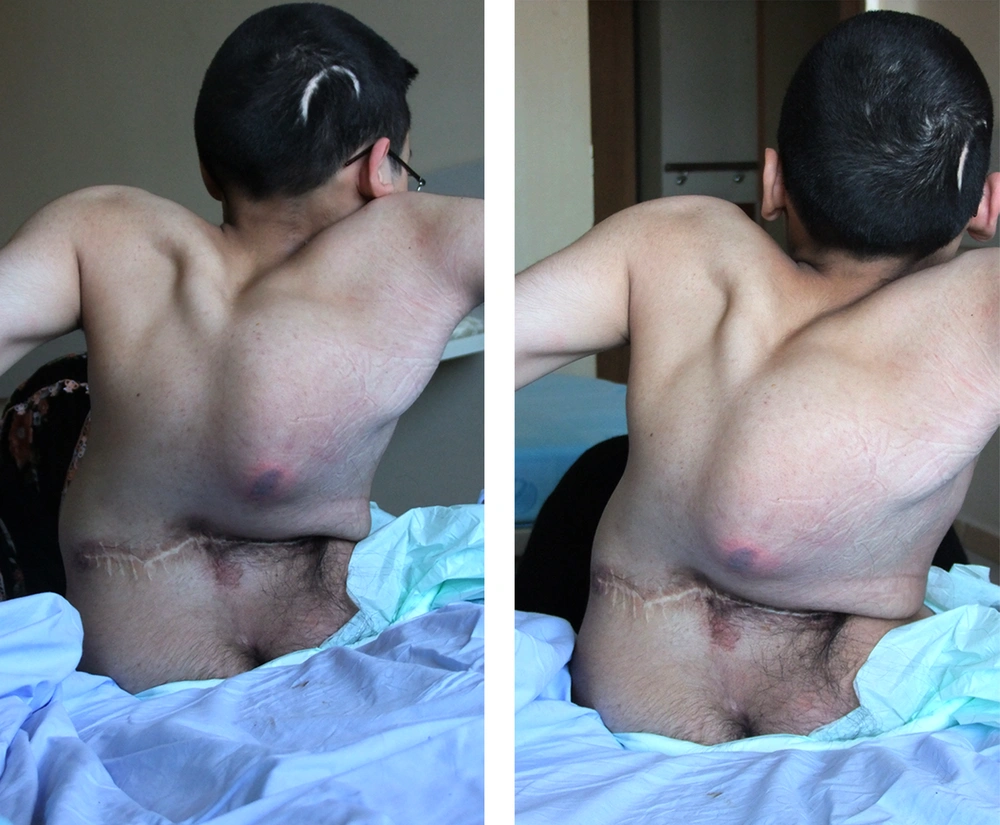Dear Editor,
This letter describes the successful use of caudal anesthesia for open bladder surgery, in a patient with advanced scoliosis and a severe form of spina bifida cystica, which had been operated during childhood. He had preserved neurological function, without neurogenic bladder.
A 16-year-old boy weighing 40 kg, conscious, cooperative and oriented, Mallampati class І, American Society of Anesthesiologists (ASA) physical status ІІІ, who had restricted lung function, because of advanced scoliosis (forced vital capacity below 45% and scoliotic curves exceeding 90 - 100°), required the open bladder operation because of recurrent calculus formation. He had been operated for neural tube defect and hydrocephalus, when he was one year old, and he had advanced scoliosis. Before the surgery, as we considered that extubation of trachea, after using muscle relaxants and anesthetics, in such a weak and deformed chest, with impaired mechanics, would be very difficult, regional anesthesia was planned (Figure 1). Regional anesthesia is kept in mind for children who are at high risk from general anesthesia (1). The parents were given information on regional and general anesthesia and their written informed consent was obtained. In the operating room, the patient underwent continuous electrocardiogram, pulse oximetry and noninvasive blood pressure monitoring. Patient’s preoperative vital signs and laboratory tests were normal. Parameters were recorded every 5 minutes. Hydration was started with lactated ringers intravenously at a rate of 100 mL/hour, considering that the excess fluid may impair lung function even more. Due to the presence of advanced scoliosis and the history of a neural tube defect operation, spinal anesthesia was not attempted. Bearing in mind that general anesthesia would be risky, although the operation was vital, and in view of the probability of the caudal space not being closed, a caudal block was attempted. The caudal space was entered with a 20-gauge needle and a 1:1 mixture of 25 mL of 0.25% bupivacaine (0.5% Marcaine, Zentiva, Istanbul, Turkey) with physiologic serum was injected slowly, after sedation with 30 mg propofol. Surgery was initiated 10 minutes from the block, after it was confirmed by pinprick that the patient did not feel pain in the subumbilical area, and the operation lasted for two hours. Approximately 50 cc blood loss was seen and no intraoperative impairment was encountered. For sedation and amnesia, 2 mg midazolam (Dormicum, Roche, Istanbul, Turkey) were administered. Spontaneous breathing was maintained with supplementary oxygen through a facemask, during the operation. The patient was asleep during the procedure and did not require additional sedation. Paracetamol (Parol, Atabay, Istanbul, Turkey) 20 mg/kg was infused for postoperative antipyretic effect, during the first 20 minutes of surgery and for postoperative analgesia. No perioperative complications (such as hypertension, tachycardia, bradycardia, hypoxemia, or apnea) were observed during surgery, and the patient felt no pain for 8 hours postoperatively, while caudal block returned after 8 hours. The patient was discharged from the hospital uneventfully, the day after the operation. Scoliosis is a disease in which anesthetic management is often difficult, as a result of muscle weakness and hypersensitivity to neuromuscular blocking agents. Patients with spinal deformities are at high risk for morbidity, because of immobilization hypercalciuria, recurrent nephrolitiasis, urinary stasis, and urinary tract infection (2). Recurrent urinary tract stones are a difficult problem in patients with spinal deformities, because of the higher rate of complications and technical difficulties (3). Pain control choices are limited for individuals with spinal dysraphism, who undergo major urologic procedures (4). Viscomi et al. (5) suggested spinal anesthesia for operations in patients with myelomeningocele. However, this suggestion viable only for patients who will undergo spina bifida operations, and not for patients who require operations for spina bifida or who have spina bifida without recommendation for surgery, or those in whom operations are planned for other reasons. As our patient had undergone surgery on the lumbar region, because of neural tube defect, and there was no problem that would prevent injection in the sacral region, caudal anesthesia was the choice. Schwartz et al. (6) implicated that caudal anesthesia is a safe method in patients with spina bifida occulta. Additionally, Johr and Berger (7) stated that caudal anesthesia is the single most simple, safe, and important anesthetic technique to provide pain relief, under the umbilicus.
In conclusion, for operations under the umbilicus, caudal anesthesia can be a good alternative in children who are at high risk from general anesthesia, because of restricted lung function, and who cannot undergo spinal anesthesia because of having myelomeningocele. In young patients such as ours, who undergo operations for myelomeningocele and have scoliosis, it is our belief that caudal anesthesia may be used reliably and effectively since it provides effective pain control in the intraoperative and postoperative periods. However, we should keep in mind the possibility of epidural adhesions at the site of previous spina bifida cystica repair, as we would not be sure that the drug should be received to the desired level in every similar cases.
